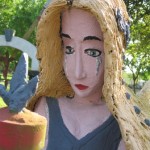
Water, art, and spirit…
Often the adventure is just as exciting as the destination and so it was with my trip to Houma, LA for a retreat at the Lumen Christi Retreat Center. My sister, Linda, flew in from Colorado and we headed out to Houma, LA with the intention to sightsee along the way. In South LA water is everywhere – rivers, bayous, lakes, swamps, estuaries and finally the gulf itself. So water became the theme of our adventure. This was not intentional, it just happened.
The Mississippi River once flowed freely into Bayou Plaquemine and was one of the 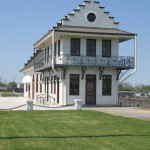 waterways the exiled Acadians used when arriving in Louisiana. After a devastating flood, the citizens of the area fought to have locks built to protect life and property. The Plaquemine Locks were completed in 1909 with the highest fresh water lift, 51 feet, of any lock in the world. The locks used a unique engineering design utilizing a gravity flow principle. The locks provided a short cut from the Mississippi River to Bayou Plaquemine and into the interior waters of Louisiana. By 1925, the locks became the northern terminus of the Intracoastal Canal System. After World War II, the increased river traffic put a strain on the locks. In 1961, a new set of locks was built at Port Allen, north of Plaquemine. After 52 years of service, the Plaquemine Locks closed. The original Lockhouse has been preserved as a museum.
waterways the exiled Acadians used when arriving in Louisiana. After a devastating flood, the citizens of the area fought to have locks built to protect life and property. The Plaquemine Locks were completed in 1909 with the highest fresh water lift, 51 feet, of any lock in the world. The locks used a unique engineering design utilizing a gravity flow principle. The locks provided a short cut from the Mississippi River to Bayou Plaquemine and into the interior waters of Louisiana. By 1925, the locks became the northern terminus of the Intracoastal Canal System. After World War II, the increased river traffic put a strain on the locks. In 1961, a new set of locks was built at Port Allen, north of Plaquemine. After 52 years of service, the Plaquemine Locks closed. The original Lockhouse has been preserved as a museum.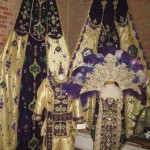
Across the street from the Lockhouse is the Iberville Parish Museumhoused in the old Courthouse and City Hall. The Mardi Gras Costume exhibit was the highlight of our visit. We learned that city’s name, Plaquemine, comes from an Indian word “Piakemine” meaning Persimmon. Wild Persimmon Trees once grew all along the bayou.
Nottoway Plantation was our lunch destination so after spending about two hours at the locks and museum, we were looking forward to the grandeur of a plantation meal. But on 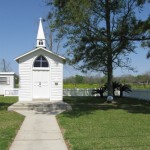 the way we stopped in for a visit at the Madonna Chapel in Bayou Goula, LA. The chapel, located on the River Road between Plaquemine and White Castle, is said to be the smallest church in the world. A farmer praying for his sick son, promised to build the chapel if his son recovered. A Catholic Mass is celebrated each year on August 15, the Feast of the Assumption. The church which is kept locked welcomes visitors. Attached to the church is a “key box” with the church key inside. Admission is free although there is a donation box.
the way we stopped in for a visit at the Madonna Chapel in Bayou Goula, LA. The chapel, located on the River Road between Plaquemine and White Castle, is said to be the smallest church in the world. A farmer praying for his sick son, promised to build the chapel if his son recovered. A Catholic Mass is celebrated each year on August 15, the Feast of the Assumption. The church which is kept locked welcomes visitors. Attached to the church is a “key box” with the church key inside. Admission is free although there is a donation box.
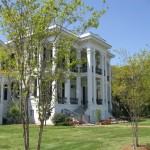 The Nottowayantebellum mansion is said to be the South’s largest. The house was built in 1857 having 50 rooms and was reported to have a bathroom on the second floor. The two story house rests on a high basement with cypress columns. Today the basement houses the restaurant with glass between the columns. With views of the massive yard and large oaks, lunch lived up to our expectations and included crawfish etouffee and red beans and rice with cornbread. After walking the grounds and admiring the flowering plants including azaleas we were off to Thibodaux, LA.
The Nottowayantebellum mansion is said to be the South’s largest. The house was built in 1857 having 50 rooms and was reported to have a bathroom on the second floor. The two story house rests on a high basement with cypress columns. Today the basement houses the restaurant with glass between the columns. With views of the massive yard and large oaks, lunch lived up to our expectations and included crawfish etouffee and red beans and rice with cornbread. After walking the grounds and admiring the flowering plants including azaleas we were off to Thibodaux, LA.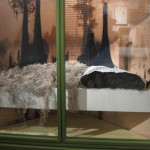
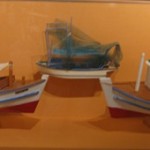 Being of Cajun descent, we wanted to explore the Jean Lafitte National Park Wetlands Acadian Cultural Center in Thibodaux. The center allows exploration of Acadians recreation, clothing, home furnishings religion, cuisine, and fishing with exhibits and artifacts. Included was an exhibit of a Moss Mattress. Cajuns used Black Moss to fill their mattresses. It was interesting to see and hear things from our childhood.
Being of Cajun descent, we wanted to explore the Jean Lafitte National Park Wetlands Acadian Cultural Center in Thibodaux. The center allows exploration of Acadians recreation, clothing, home furnishings religion, cuisine, and fishing with exhibits and artifacts. Included was an exhibit of a Moss Mattress. Cajuns used Black Moss to fill their mattresses. It was interesting to see and hear things from our childhood.
 From Thibodaux we headed further south down the bayou. We were headed to Chauvin, LA, a small town (approx. 3300) on Bayou Terrebonne very near the marshes of south Louisiana.
From Thibodaux we headed further south down the bayou. We were headed to Chauvin, LA, a small town (approx. 3300) on Bayou Terrebonne very near the marshes of south Louisiana. 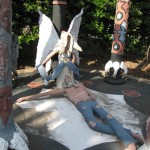 Why Chauvin? Chauvin is the home of the Kenny Hill Sculpture Garden. In 1988, Hill, a bricklayer, settled on bayou property pitching a tent, later building a rustic home. In 1990, he began transforming the property with sculptures. By early January 2000, after creating over 100 concrete sculptures, Hill walked away. Most of the pieces have religious orientation although there is a 45 foot lighthouse with figures clinging to the outside. Walking through the garden, you realize Hill must have had turmoil in his life and used the sculptures as his outlet. The sculptures are somewhat bizarre and eclectic. Today the garden is owned and maintained by Nicholls State University and is free to visit.
Why Chauvin? Chauvin is the home of the Kenny Hill Sculpture Garden. In 1988, Hill, a bricklayer, settled on bayou property pitching a tent, later building a rustic home. In 1990, he began transforming the property with sculptures. By early January 2000, after creating over 100 concrete sculptures, Hill walked away. Most of the pieces have religious orientation although there is a 45 foot lighthouse with figures clinging to the outside. Walking through the garden, you realize Hill must have had turmoil in his life and used the sculptures as his outlet. The sculptures are somewhat bizarre and eclectic. Today the garden is owned and maintained by Nicholls State University and is free to visit.
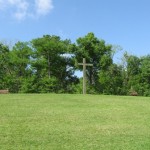 After nine hours of discovery and enjoying the sights and sounds
After nine hours of discovery and enjoying the sights and sounds 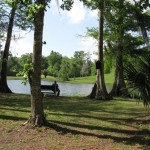 along Louisiana’s waterways, we arrived at the Lumen Christi Retreat Center to begin our retreat.
along Louisiana’s waterways, we arrived at the Lumen Christi Retreat Center to begin our retreat.

